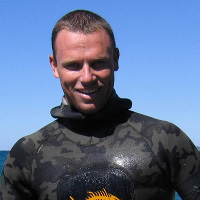
Heath Folpp
BSc (SCU)
 School of Biological Earth and Environmental Science
School of Biological Earth and Environmental Science
University of New South Wales
Sydney NSW 2052
AUSTRALIA
and
Department of Primary Industries - Fisheries
PO Box 21,
Cronulla NSW 2230
Email: heath.folpp at dpi.nsw.gov.au
Research Interests
Heath Folpp studied a Bachelor of Applied Science (Marine Science) at Southern Cross University (SCU). Heath completed his degree at the National Marine Science Centre (NMSC) in Coffs Harbour, graduating in 2003. Just before finishing his studies, Heath was employed by NSW Fisheries (now NSW Department of Primary Industries [DPI]) to implement a Fish Aggregating Devices (FADs) program to enhance pelagic fishing opportunities for recreational fishers. While working full time, Heath completed his Honours, looking at environmental factors that influence dolphinfish (Coryphaena hippurus) catch around FADs. In 2004, while continuing to develop the FADs program, Heath began work on artificial reefs as a possible recreational fisheries enhancement tool.
Artificial reefs and the materials used to construct them have evolved considerably in recent year’s inline with stringent environmental legislation. NSW has had a chequered history of artificial reef construction, beginning in the early 1970’s with used car tyres in a number of coastal estuaries and , until recent years, effectively stopping in the mid 1980’s with the sinking of a number of small vessels around the Sydney region for artificial fishing reefs. Artificial reefs have historically been viewed as a convenient method for waste disposal. However, stringent controls over the placement of any materials into the marine environment have meant that considerable advancements in artificial reef R&D have been made. As a result, modern artificial reefs are constructed using design specific materials aimed to meet clearly defined objectives. Using ‘Reef Ball’ (RB) technology, Heath managed the approval, design and deployment of a total of 18 small artificial reefs in three NSW estuaries (Lake Macquarie, Botany Bay and St Georges Basin) between December 2005 and February 2007. In total 180 RB units were deployed in each estuary, divided into six small artificial reef groups of approximately 30 RB’s each. In 2006, Heath began his PhD at UNSW, looking at the potential use of artificial reefs as a fisheries enhancement tool in estuarine waters. Baited remote underwater video (BRUV), diver census and photographic surveys are being used to investigate the development and succession of marine finfish populations overtime on artificial structures and assess the potential for design specific artificial reefs to mimic natural habitat. Additionally, the effect of reef size, proximity to open ocean influences and reef depth are also being examined. More recently Heath has been involved in the development of new BRUV technology with the use of programmable flash memory cameras.
The project is funded by the NSW Saltwater Recreational Fishing Trust and has led to DPI investigating the potential for the use of artificial reefs in NSW offshore (open ocean) waters.
